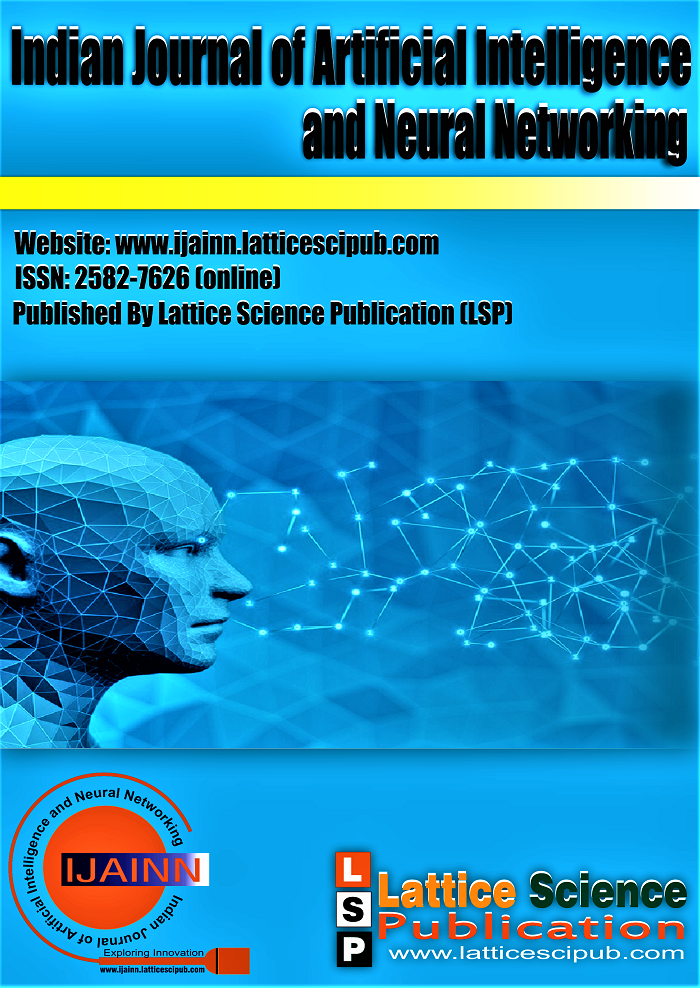Mitigating Peak Sidelobe Levels in Pulse Compression Radar using Artificial Neural Networks
Main Article Content
Abstract
In this paper, Artificial Neural Networks (ANNs) are being considered to obtain low sidelobe pattern for binary codes and thereby to improve the performance of pulse compression radar. Pulse compression is a popular technique used for improving range resolution in the radar systems. This paper proposes a new approach for Pulse Compression using various types of ANN networks like Multi-Layer Perception (MLP), Recursive Neural Networks (RNN), Radial Basis Function (RBF) and Recurrent Radial Basis Function (RRBF) and a special class of Feed-Forward Wavelet Neural Network (WNN) with one input layer, one output layer and one hidden layer are being considered. Networks of 13-bit Barker code and extended binary Barker codes of 35, 55 and 75 length codes were used for the implementation and thereby to improve the performance of pulse compression radar. WNN-based networks using Morlet and Sigmoid activation function in hidden and output layers respectively, a special class of Artificial Neural Network is considered in this paper. The performance metrics used are Peak Sidelobe Ratio (PSLR), Integrated Sidelobe Ratio (ISLR) and Signal-to-Sidelobe Ratio (SSR). Further the performance in terms of range and Doppler resolution is also presented in this paper. Better performance in terms of sidelobe reduction can be achieved with ANNs compared to Autocorrelation Function (ACF) called as matched filter. If the sidelobe values are high there is possibility of masking weaker return signals and there by detection becomes difficult. From this paper it can be established that RRBF gives better result than other ANN networks. Further, WNN gives the best performance even compared with RRBF in terms of sidelobe reduction in pulse compression radar.
Downloads
Article Details

This work is licensed under a Creative Commons Attribution-NonCommercial-NoDerivatives 4.0 International License.
How to Cite
References
I.-C. Vizitiu, F. Enache, and F. Popescu, “Sidelobe reduction in pulse-compression radar using the stationary phase technique: An extended comparative study, “in 2014InternationalConferenceonOptimizationofElectrical and Electronic Equipment (OPTIM),2014 https://doi.org/10.1109/OPTIM.2014.6850932
I.Cohenand, N. Levanan,“Weight windows–An improvedapproach”, in 2014 IEEE 28th Convention of Electrical & ElectronicsEngineersinIsrael (IEEEI),2014.
M.UttaraKumari,K.R. Rajeswari, andM.K. Krishna,“Lowsidelobe pattern using Woo filter concepts‖,” Int.J. Electron Commun. (AEU), vol.59, pp.499–501,2005. https://doi.org/10.1016/j.aeue.2004.11.045
N. Levanan and E. Mozesan, “Radar Signals,” John Wiley & sonsInc.2004.
Rohling H. 1990. Mismatched filter design for pulse compression. In: Radar Conference, 1990. Record of the IEEE 1990 International. IEEE. Pp. 253-257.
Zhang L., Wang X., Huang Y. and Peng Y. 2000. A time domain synthesized binary phase code sidelobe suppression filter based on genetic algorithm. In Signal Processing Proceedings, 2000. WCCC-ICSP 2000. 5th International Conference on. 3: 1907-1910.IEEE.
N. LevananE. Mozesan,“Nullifying AC Fgrating lobesinstepped frequency train of LFM pulses‖IEEE Trans. on AerospaceandElectronicSystemsAES-39,” pp.694–703,2003. https://doi.org/10.1109/TAES.2003.1207275
N. Levanan, E. Mozesan,“‖Modified Costas Signal‖,” IEEETrans.onAerospace and Electronic SystemsAES,vol. 40, no.3, pp.946–995,2004. https://doi.org/10.1109/TAES.2004.1337466
T. AnkurandT. Salman Raju,“A Novel pulse compression Technique for sidelobe reduction using Woo Filter concepts”, IEEEE Xplore, International Conference on Communications and Signal Processing (ICCS),2017.
B. V. Rao and A. A. Deshpande, “Why the Barker sequence bit length does not exceed thirteen,” Journal of IETE, vol. 34, 1988. https://doi.org/10.1080/03772063.1988.11436770
Z.-J. Wu, C.-X. Wang, P.-H. Jiang, Z.-Q. Zhou, and ‖. Range, “‖Range-Doppler SidelobeSuppressionforPulsedRadarBasedonGolayComplementaryCodes‖,” IEEESIGNALPROCESSINGLETTERS, vol.27, pp.1205–1209,2020.
W. Jiang, Y. Ren, Y. Liu, and J. Leng, “Artificial neural networks and deep learning techniques applied to radar target detection: A review,”Electronics(Basel),vol.11,no.1,p.156,2022. https://doi.org/10.3390/electronics11010156
H. Saeedi, M. R. Ahmadzadeh, and M. R. Akhavan, “‖Application of neural network to pulse compression‖,” IETInternationalConferenceonRadar systems,pp.1–6,2007. https://doi.org/10.1049/cp:20070512
D. G. Khairnar, S. N. Merchant, and U. B. Desai, “Radial basis neuralnetwork approach to pulse radar detection, IET Radar Sonar Navig,”vol. 1,pp.8–17,2007. https://doi.org/10.1049/iet-rsn:20050023
Zhang Q. and Benveniste A. 1992.Wavelet networks. Neural Networks, IEEE Transaction on. 3(6): 889-898. https://doi.org/10.1109/72.165591
Chen Z., Feng T. J. and Meng Q. C. 1999. The application of wavelet neural network in time series prediction andsystem modelling based on multiresolution learning. In Systems, Man and Cybernetics,1999. IEEE SMC'99 Conference Proceedings. 1999 IEEE International Conference pp425-430.
Alexandrite A.K and Zapranis A.D Wavelet Neural Networks with applications in financial engineering, Chaosandclassification,2014https://doi.org/10.1002/9781118596272
Heaton Jeff. 2008. Introduction to neural networks with Java. Heaton Research, Inc.
Giustolisi O. and Laucelli D. 2005. Improving generalization of artificial neural networks in rainfall–runoffmodelling/Amelioration de la generalization de reseaux de neuronsartificial pour la modulization pluie-débit.Hydrological Sciences Journal. 50(3). https://doi.org/10.1623/hysj.50.3.439.65025
M.J.E.Golay,“Sievesforlowtocorrelationbinarysequences,”IEEE Transaction on Information Technology ,no. 23, pp.43–51,1977. https://doi.org/10.1109/TIT.1977.1055653
Modified Radar Signal Model using NLFM. (2019). In International Journal of Recent Technology and Engineering (Vol. 8, Issue 2S3, pp. 513–516). https://doi.org/10.35940/ijrte.b1091.0782s319
Kasthuri, Dr. N., & Yuvashree, S. (2020). Solution for the Problems in RADAR Systems from SNR Gain Expressions and Blackout Likelihood Detection for Aviation Systems. In International Journal of Innovative Technology and Exploring Engineering (Vol. 9, Issue 5, pp. 980–982). https://doi.org/10.35940/ijitee.d1516.039520
Pramil, Prateek, & Parashuram. (2020). Band Pass Semi Adaptive Digital Filters for Radar Applications. In International Journal of Engineering and Advanced Technology (Vol. 9, Issue 3, pp. 4184–4186). https://doi.org/10.35940/ijeat.c5017.029320
Ganesh, Dr. E. N. (2022). Analysis of Velocity Measurement of Radar Signal in Space Vehicle Application using VLSI Chip. In Indian Journal of VLSI Design (Vol. 2, Issue 1, pp. 16–20). https://doi.org/10.54105/ijvlsid.c1207.031322
A., O., & O, B. (2020). An Iris Recognition and Detection System Implementation. In International Journal of Inventive Engineering and Sciences (Vol. 5, Issue 8, pp. 8–10). https://doi.org/10.35940/ijies.h0958.025820





